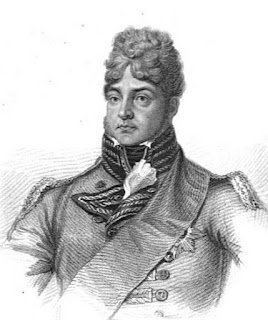 | |
| The first quadrille at Almack's from The Reminiscences and Recollections of Captain Gronow (1850) |
I love Regency romances. The Regency is a period ruled by elegance and etiquette. It is a romantic world full of balls and duels, Corinthians and debutantes, Almack’s and Vauxhall Gardens, and rakes reformed by love.
When I started to blog about Regency history, I was motivated by wanting to explore the historical background to the Regency romances that I love to read so that I could write my own. And yet I have often picked up a ‘Regency’ romance, only to find that it is set in 1823 and not set in the Regency at all!
The strict definition of the Regency period
The Regency lasted a mere nine years, from February 1811 until January 1820. In 1810, George III was taken seriously ill. He was declared incapable of ruling because of mental incapacity and the Regency Act was passed the following year making his son George Prince Regent to rule in his stead. The Regency lasted until George III’s death in 1820 when the Regent became King George IV and was able to rule in his own right.
Regency feel
So why is it that not all Regency romances are set in the period 1811 to 1820? And if they are not set in the Regency, why do we call them Regency romances?
I believe the answer lies in the ‘feel’ of the Regency. The term Regency has come to represent a much wider period of time than the nine years to which it actually relates.
The Regent
 |
| George IV from Huish's Memoirs of her late royal highness Charlotte Augusta (1818) |
The Regency period is epitomised by the Regent himself. As a young man, George IV was a handsome and personable figure, described as ‘the first gentleman of England’. The romantic figure of Prinny had almost disappeared by the time the long-awaited Regency started. He had become fat and his extravagant habits had made him unpopular and, as the years progressed, he became more and more reclusive.
But to the modern reader, the Regent in his youth represents the world of glamorous elegance, extravagant follies and romantic liaisons. It is this image of George IV as a young man that embodies the Regency, an image that was established long before he ever became Regent.
Romanticism
The Romantic Movement was well-established by the time the Regency started. This was a time that was rich in literature, both poetry and prose. It was the time of the Romantic poets like Wordsworth, Byron, Coleridge and Shelley and the Romantic novelist, Sir Walter Scott. Constable and Turner were painting and Beethoven was composing. The Regency finished, but the Romantics went on.
Jane Austen
The works of Jane Austen are inextricably linked to the Regency. All six of Jane Austen’s completed novels were published during this period, making them archetypal Regency romances. But they were not wholly written during the nine years of the Regency and although Jane died before the Regency ended, her books lived on.
Regency style
The Regency is associated with a style of architecture, furniture and design that spans more than a single decade. The Encyclopaedia Britannica describes Regency style as the
... decorative arts produced during the Regency of George, Prince of Wales, and the opening years of the 19th century as well as his entire reign as King George IV of England, ending in 1830.1
Saul David in his biography of George IV describes the Regency ‘in its widest sense (1800-1830)’ as a ‘devil-may-care period of low morals and high fashion’.2
A notice at the entrance to the Regency galleries in the National Portrait Gallery suggests an even wider time span:
As a distinctive period in Britain’s social and cultural life, the Regency spanned the four decades from the start of the French Revolution in 1789 to the passing of Britain’s great Reform Act in 1832.3
 |
| Ball dress from La Belle Assemblée (1816) |
The Regency era is, by very definition, related to the life of the Regent. It is characterised by the freedom and extravagance of George IV compared with the ascetic lifestyle of his father. Although the Regency is a mere nine years long, I am inclined to think that the Regency ‘feel’ starts around the time that George IV came of age in 1783 and continues until his death in 1830. This is sometimes referred to as the 'long Regency'.
Perhaps ‘Regency’ romances can be set in 1823 after all!
 Rachel
Knowles writes clean/Christian historical romance set in the time of Jane
Austen. She has been sharing her research on this blog since 2011. Rachel lives
in the beautiful Georgian seaside town of Weymouth, Dorset, on the south coast
of England, with her husband, Andrew.
Rachel
Knowles writes clean/Christian historical romance set in the time of Jane
Austen. She has been sharing her research on this blog since 2011. Rachel lives
in the beautiful Georgian seaside town of Weymouth, Dorset, on the south coast
of England, with her husband, Andrew.
Find out more about Rachel's books and sign up for her newsletter here.
If you have enjoyed this blog and want to encourage me and help me to keep making my research freely available, please buy me a virtual cup of coffee by clicking the button below.
Notes
- Encyclopaedia Britannica 15th edition (1994, Encyclopaedia Britannica Inc).
- David, Saul, The Prince of Pleasure (Little, Brown & co., 1998).
- From a sign in the National Portrait Gallery, London (2012).
David, Saul, The Prince of Pleasure (Little, Brown & co., 1998)
Encyclopaedia Britannica 15th edition (1994, Encyclopaedia Britannica Inc)
Gronow, Captain, The Reminiscences and Recollections of Captain Gronow (1850)

Rachel,
ReplyDeleteI have read some articles that consider the "Regency Era" (as opposed to the Regency Period of 1811-1820), to extend to 1837, ending when Queen Victoria succeeded William IV.
Regan
Thanks for your comment, Regan. I think distinguishing between the Regency era or Regency-style era and the actual Regency is quite helpful. Clearly the latter is not negotiable, but there are a lot of different opinions as to how long the Regency era lasted, depending on what characteristics you consider are the most important.
DeleteRachel
What characteristics do you think are the most important about the regency time period?
DeleteAll the elements of fashion, style and literature are spread over the wider Regency era. What characterises the Regency period itself ie 1811-20, is that the country was ruled by the Regent on behalf of the King. A key event during this period was the Battle of Waterloo and the ensuing peace with France.
DeleteI always think of the Regency as having "arrived" sometime around the turn of the century, perhaps because of the change in fashion and the end of the French Revolution. This is probably a very arbitrary way of looking at it, but it's mine and I'm sticking to it! As for the end of the era, books set in the 1820s seem a little "late" to me, but again, that's just me.
ReplyDeleteI think you're right in saying that there is a "feel" or a "style" to the Regency, at least as perceived by those of us who love the period and the regency romance. As long as an author captures that milieu, it doesn't matter whether the book is set within those nine years or not.
Nice to hear from you, Jillian. I agree that what we think of as Regency fashion is in vogue for a much shorter period of time than my Regency-style era. I think this is very subjective depending on what criteria are most important to you - I have gone for a wider period because I have focused on the life of the Regent.
DeleteRachel
Yes, I too believe that the Regency era is defined by the man who was Regent, rather than by the years when he held that title. Though I do get tempted to think of the late 1820s as full of prototype Victorians.
ReplyDeleteSmashing post
Charlotte Frost
Thanks for your comments, Charlotte, and nice to see you like my theory :) As for the late 1820s, I guess George was not very active then, so the Regency was definitely winding down!
DeleteRachel
Great post on the Regency era. I've recently became an avid reader of the Regency romance genre, and I made a lot of pickups at yardsales. Some books have a handy label of "Regency" on the side, but some require a closer look to know where they fit. If I use your guidelines, I should be able to know by the date whether or not the book will give me the feeling I want.
ReplyDeleteGlad you found my blog helpful. Hope you enjoy reading Regency romances for many years to come!
DeleteRachel
Such a great post. I've always been a little doubtful of the actual period but I do love your comment that there is a certain feel to a Regency. I think the "tone" is the all important factor. Thanks for all the helpful info.
ReplyDeleteThanks, Karla. Glad that you liked my post.
ReplyDeleteRachel
Thanks for this post! I've often picked up a novel purporting to be a Regency romance only to find that it's set "outside" the actual Regency, and it has made me wonder! This explains it nicely!
ReplyDeleteI'm glad it has helped. There seems to be a lot of confusion about things purporting to be Regency when in fact they are in the Regency style but not the time-frame of the actual Regency.
DeleteRegards
Rachel
Interesting post! I like the term "long Regency" because it conveys the feel of a stylistic period. When I write "Regency" novels I never go past 1820 because I don't like the change in fashions, which is probasbly a very frivolous reason!
ReplyDeleteFashion is a defining feature of the Regency. Once the waistlines begin to drop and the Grecian-style simplicity disappears, Regency fashion is over. It sounds perfectly reasonable to me, and not frivolous at all, to use fashion to define the end of the Regency!
ReplyDeleteI guess it is also important to consider that 3 periods sort of overlapped here. There' the Regency, the Federal, and the french Imperial periods that all sort of existed in this time frame. From a fashion perspective the wider range is definitely applicable because the french Imperial period began before the official Regency, and the american Federal period ran through there too. I find it easy to mix up dates when so many of the fashions and social behaviours were the same.
ReplyDeletevery informative post
ReplyDelete